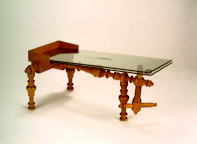
35 x 23 x 13
Boxwood and glass
INDEX 1788 : LI. IV.37
Machina ex Buxo tribus pedibus, capsula, Cochlea, quatuorque planis speculis constans.
Boxwood machine with three feet, composed of a box, a screw and four flat sheets of glass.
This equipment is designed for one of the most interesting and most delicate experiments carried out in 18th century physics laboratories. The "boxwood apparatus" referred to by the Index Instrumentorum is a three legged table without a top, over which are placed two sheets of glass. These can be placed horizontally or obliquely by means of a large wooden screw that raises or lowers the glass sheets as required by the experimenter.
In order to do the experiment, the sheets of glass must not lie directly one on top of the other, so a coin or little thin disc is placed between them on the side of the box opposite to the screw to keep them separated. In this way the distance between the glass plates diminishes progressively until they touch. The upper sheet of glass is raised, and a drop of water (or oil) placed in the middle of the lower one. The glass is then inclined at an angle, by turning the screw carefully so that the drop does not trickle off. The upper sheet is lowered again, so that the drop now situated between the sheets of glass touches the surfaces very lightly. It will then be observed that, if the sheets are put into a sloping position by turning the screw, at a certain angle, the drop begins to rise spontaneously up the inclined plane, instead of descending along it.
The explanation of this apparently unexpected result is as follows. On contact between the drop and the two glass surfaces there is competition between the cohesive forces of the water molecules Fc, and the forces of adhesion of these molecules with the surface of the glass, Fa. In the case of the water-glass contact, it can be verified that Fa > Fc, since the drop tends towards a form that maximises the area of contact. In this case the drop is subject to the attraction of the two glass plates, between which it is contained. However, the attraction from the highest side is greater than that of the lowest, because on the highest side the thickness of the drop between the two plates is less, the area of contact greater, and therefore the action on the drop is more intense. The difference between these forces causes the drop of water or oil to rise between the glass plates.
It is to be noted that the increase in the potential gravitational energy of the drop is compensated by the reduction in its surface energy, since its area of contact with the air is progressively reduced during the climb. It is this subtlety which makes this such an interesting experiment to demonstrate.
From Colégio dos Nobres, catalogue n.º 37.
Carvalho, Rómulo de, História do Gabinete de Física da Universidade de Coimbra, Universidade de Coimbra, Biblioteca Geral, Coimbra, 1978, pp. 166-168.
Dalla Bella, Giovanni Antonio, Physices Elementa, 1970, § XIII, p. 70.